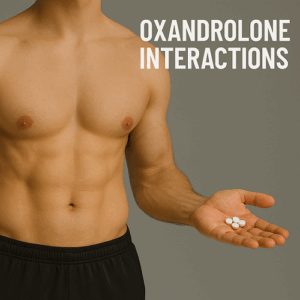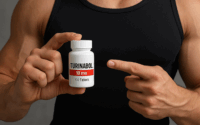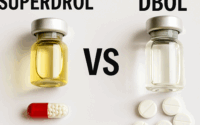Oxandrolone Interactions
 Oxandrolone Interactions: Understanding the Hidden Risks for Athletes and Bodybuilders
Oxandrolone Interactions: Understanding the Hidden Risks for Athletes and Bodybuilders
Oxandrolone, commonly known as Anavar, is one of the most popular anabolic steroids in the fitness world, prized for its muscle-preserving, fat-burning, and strength-enhancing effects. Unlike many other anabolic steroids, Oxandrolone is considered milder, making it a favorite among cutting athletes and female competitors. However, despite its reputation as a “gentle” steroid, Oxandrolone can interact with a wide range of supplements, medications, and lifestyle factors in ways that are often overlooked.
Understanding these unrepeatable interactions is crucial for anyone looking to maximize results while minimizing risks with Oxandrolone. This guide explores the lesser-known, unexpected interactions that can significantly impact your health, performance, and results.
Uncommon and Overlooked Oxandrolone Interactions
1. Thyroid Hormone Synergy and Metabolic Overload
While Oxandrolone is often used for its fat-burning properties, stacking it with thyroid hormones like T3 (Liothyronine) or T4 (Levothyroxine) can overload the metabolic system. This combination can:
-
Accelerate fat loss to the point of muscle wasting
-
Increase protein breakdown
-
Cause metabolic crashes when the cycle ends
-
Disrupt thyroid hormone balance long-term
Safer Stacking Tips:
-
Use natural thyroid support like iodine and selenium instead.
-
Monitor thyroid function regularly to prevent crashes.
-
Cycle off thyroid hormones periodically to reset the system.
2. Elevated Blood Pressure with Stimulants
Oxandrolone can raise blood pressure by increasing red blood cell count and blood viscosity. When combined with stimulants like caffeine, ephedrine, or pre-workout supplements, this can dramatically increase cardiovascular strain.
Potential Risks Include:
-
Hypertension
-
Increased risk of heart attack and stroke
-
Arrhythmias and palpitations
-
Severe headaches and nosebleeds
Better Alternatives:
-
Use non-stimulant pre-workouts with NO boosters like citrulline malate or beta-alanine.
-
Monitor blood pressure regularly, especially during heavy training cycles.
3. Cholesterol Disruption and Omega-3 Imbalance
Oxandrolone is known to reduce HDL (good) cholesterol and increase LDL (bad) cholesterol, creating an unfavorable cholesterol profile. However, this effect can be amplified by omega-6 fatty acids commonly found in processed foods and seed oils.
Practical Prevention:
-
Increase omega-3 intake through fish oil or krill oil.
-
Limit omega-6 sources like vegetable oils, margarine, and fried foods.
-
Use antioxidant-rich supplements like astaxanthin to protect arterial health.
4. Liver Enzyme Interference with Painkillers and NSAIDs
While Oxandrolone is less hepatotoxic than many other oral steroids, it still places stress on the liver. This risk can be significantly increased when combined with painkillers like acetaminophen (Tylenol) or NSAIDs like ibuprofen.
Potential Consequences Include:
-
Elevated liver enzymes
-
Increased risk of liver inflammation and jaundice
-
Slower liver recovery post-cycle
-
Reduced muscle protein synthesis due to impaired liver function
Safer Pain Management Options:
-
Use natural anti-inflammatories like curcumin or boswellia.
-
Consider topical pain relief for localized injuries.
-
Limit alcohol and other liver-stressing substances during cycles.
5. Electrolyte Imbalance with Diuretics
Many athletes use diuretics like furosemide or hydrochlorothiazide to cut water weight before a competition. However, this can deplete potassium and sodium, both of which are essential for muscle contraction and nerve function.
Risks Include:
-
Severe muscle cramps
-
Weakness and fatigue
-
Increased risk of cardiac arrhythmias
-
Dehydration and electrolyte collapse
Safer Alternatives:
-
Use natural diuretics like dandelion root or caffeine in moderation.
-
Supplement with electrolyte powders or sports drinks to maintain balance.
6. Mental Health Interference with Antidepressants
Oxandrolone can alter brain chemistry by affecting neurotransmitter levels like dopamine and serotonin. This can negatively interact with antidepressants or SSRIs like Prozac or Zoloft, leading to:
-
Increased anxiety and irritability
-
Mood swings and emotional instability
-
Reduced effectiveness of mental health medications
-
Long-term changes in neuroplasticity
Mental Health Precautions:
-
Avoid stacking Oxandrolone with SSRIs or MAO inhibitors.
-
Use natural mood stabilizers like ashwagandha or L-theanine.
-
Practice stress management and meditation during cycles.
7. Insulin Sensitivity Disruption
Oxandrolone can increase insulin sensitivity, which is beneficial for muscle growth but can backfire if combined with high-carb diets or insulin-mimicking supplements like berberine.
Potential Problems Include:
-
Blood sugar crashes during intense workouts
-
Increased fat storage if carb intake is too high
-
Energy swings and brain fog
Safer Approaches:
-
Use carb cycling to control insulin spikes.
-
Monitor blood sugar levels during cycles.
-
Focus on low-glycemic carb sources for stable energy.
Conclusion
While Oxandrolone is often seen as a “mild” steroid, its interactions with other drugs, supplements, and dietary factors can significantly amplify risks if not carefully managed. Understanding these unrepeatable interactions can help athletes and bodybuilders maximize benefits while minimizing health risks.
Before starting any Oxandrolone cycle, consult with a medical professional and prioritize health and safety over rapid results.


